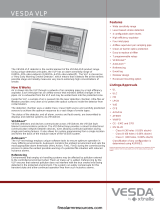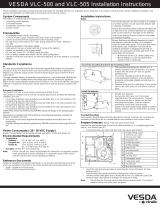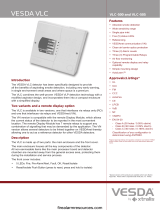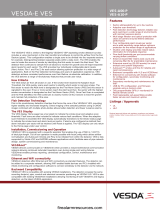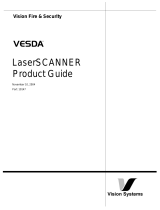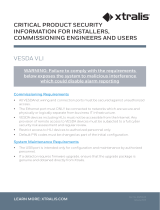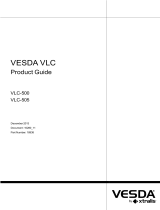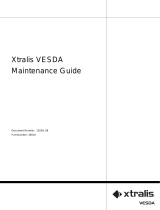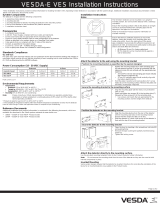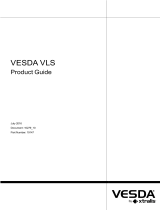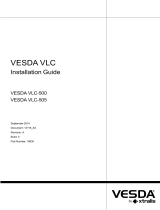
Xtralis VESDA
®
Xtralis VESDA VLP Product Guide
www.xtralis.com iii
Codes and Standards Information for Air Sampling Smoke Detection
We strongly recommend that this document is read in conjunction with the appropriate local codes and standards for smoke detection and
electrical connections. This document contains generic product information and some sections may not comply with all local codes and
standards. In these cases, the local codes and standards must take precedence. The information below was correct at time of printing but
may now be out of date, check with your local codes, standards and listings for the current restrictions.
FCC Compliance Statement
This equipment has been tested and found to comply with the limits for a Class B digital device, pursuant to part 15 of the FCC Rules.
These limits are designed to provide reasonable protection against harmful interference in a residential installation. This equipment
generates, uses and can radiate radio frequency energy and, if not installed and used in accordance with the instruction, may cause
harmful interference to radio communications. However, there is no guarantee that interference will not occur in a particular installation. If
this equipment does cause harmful interference to radio or television reception, the user is encouraged to try to correct the interference by
one or more of the following measures; re-orientate or relocate the receiving antenna, increase the separation between the equipment and
receiver, connect the equipment to a power outlet which is on a different power circuit to the receiver or consult the dealer or an
experienced radio/television technician for help.
FDA
This VESDA product incorporates a laser device and is classified as a Class 1 laser product that complies with FDA regulations 21 CFR
1040.10. The laser is housed in a sealed detector chamber and contains no serviceable parts. The laser emits invisible light and can be
hazardous if viewed with the naked eye. Under no circumstances should the detector chamber be opened.
FM Hazardous Applications
3611 Hazardous Approval Warning: Exposure to some chemicals may degrade the sealing of relays used on the detector. Relays used on
the detector are marked “TX2-5V”, “G6S-2-5V” or “EC2-5NU”.
VESDA detectors must not be connected or disconnected to a PC while the equipment is powered in an FM Division 2 hazardous
(classified) location (defined by FM 3611).
FM Approved Applications
The product must be powered from VPS-100US-120, VPS-100US-220 or VPS-220 only.
ONORM F3014
ONORM F3014, transport times for all tubes (including capillaries) must not exceed 60 seconds from any hole. This means that the pre-
designed pipe networks that include capillaries cannot be used.
AS1603.8
The performance of this product is dependent upon the configuration of the pipe network. Any extensions or modifications to the pipe
network may cause the product to stop working correctly. You must check that ASPIRE2 approves alterations before making any changes.
ASPIRE2 is available from your VESDA ASD distributor.
AS1851.1 2005
Maintenance Standards. Wherever this document and the AS1851.1 differ, AS1851.1 should be followed in preference to this document.
European Installations
The product must use a power supply conforming to EN54: Part 4.
Regional Regulatory Requirements and Notices
UL
For open area protection the fire alarm threshold (signal) that initiates an evacuation procedure via the Fire Alarm Panel must not be set
less sensitive than 0.625%/ft. The detector can send this signal via the Fire Alarm Panel Output signal or the Pre-alarm output signal.
EN54-20
The product must use a power supply conforming to EN 54-4.
The product is compliant with EN 54-20 sensitivity requirements provided the following conditions are met:
• For a Class A detector, hole sensitivity must be better than 1.5% obscuration/m and transport time less than 60 seconds
• For a Class B detector, hole sensitivity must be better than 4.5% obscuration/m and transport time less than 90 seconds
• For a Class C detector, hole sensitivity must be better than 10% obscuration/m and transport time less than 120 seconds
These limits should be verified using ASPIRE2 during the design of the sampling pipe network.
The product is compliant with EN 54-20 flow monitoring requirements provided the following conditions are met:
• The minor low and minor high flow thresholds should be set at 85% and 115% respectively
• The flow through the detector predicted by ASPIRE2 should be in the range 20 to 115 lpm
Additional information:
• Class A detectors passed EN 54-20 approvals testing with 30 holes and 0.05% obscuration/m detector sensitivity
• Class B detectors passed EN 54-20 approvals testing with 60 holes and 0.06% obscuration/m detector sensitivity
• Class C detectors passed EN 54-20 approvals testing with 100 holes and 0.08% obscuration/m detector sensitivity




















